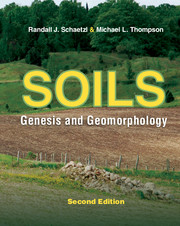1 - Introduction
Published online by Cambridge University Press: 12 January 2024
Summary
Soil landscapes and their spatial variation are exciting and complex. But to understand soils fully, they must be studied in space and time. Indeed, we embrace Daniels and Hammer's (1992) statement that soils are four-dimensional systems, not simply the one-dimensional profile. In this book we incorporate these ideas by synthesizing complex, overlapping topics and use this knowledge to help answer the questions: How do soil landscapes form? How and why do they change through time?
Soil genesis and geomorphology, the essence of this book, cannot be studied without a firm grasp on the processes that shape the distributions of soils – their complex patterns. Unfortunately, we will never fully understand the complex patterns of the Earth's soils. And even if we do aim to understand them, we must be mindful that the pattern is ever-changing. Again we quote Daniels and Hammer (1992: xvi): “One cannot hope to interpret soil systems accurately without an understanding of how the landscape and soils have coevolved over time” (emphasis ours). Every percolation event translocates some material (however minute) within a soil, while every runoff event moves material across its surface, changing the soil landscape ever so slightly. The worms, termites, and badgers that continually burrow, mix, and churn soils make them different than they were yesterday. Chemical and biochemical reactions within soils weather minerals and enable microbes to decompose organic matter, perpetuating the cycle from living matter to humus to chemical elements and back again. Like landscapes, soils evolve; changing patterns of soils over time are a reflection of a multitude of interactions, processes, and factors, replete with feedbacks, inertia, and flows of energy and mass. Yes, soils are a challenge! For that reason, we provide information, tools, resources, and background data to draw the reader closer to deciphering this most complicated – and important – of natural systems.
Whitehead (1925) wrote, “It takes a genius to undertake the analysis of the obvious.” All people who walk the Earth's surface depend on the soil, yet the soil is not obvious to all. It is seemingly everywhere, and yet comparatively few study it. Additionally, soils are usually hidden from view and require excavation to be revealed. Neither are soils discrete entities like trees, insects, or lakes, which have clearly defined outer boundaries.
- Type
- Chapter
- Information
- SoilsGenesis and Geomorphology, pp. 3 - 7Publisher: Cambridge University PressPrint publication year: 2015

